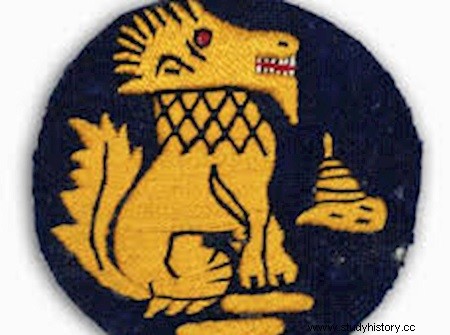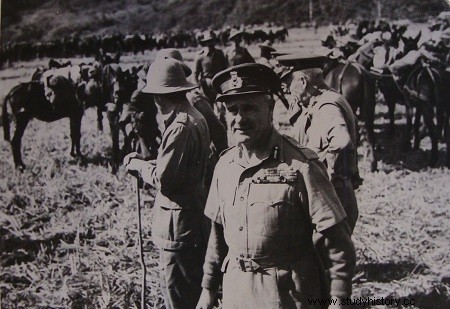
The Chindits are a military force of the United Kingdom Army, active during the Second World War under the official names of the 77th Indian Infantry Brigade (in 1943) and the Indian 3rd Infantry Division (in 1944).
They were trained and led by General Orde Charles Wingate. The Chindits operated far behind the front line during the Burma campaign, to sow disorder and instil a sense of insecurity among Japanese forces circulating from China to India on the mainland. The Chindits were totally dependent on airdrop supplies. There were two Chindits expeditions to Burma, the first was in February 1943 with Operation Longcloth consisting of a force of 3,000 men who marched through the jungle for 1,600 km throughout the campaign. The second expedition was Operation Thursday in March 1944 which was on an even larger scale. It was the second largest airborne invasion operation of the war carried out by 20,000 British and Commonwealth troops with the support of Philip Cochran's Air Commando of the USAAF. A few weeks after the launch of this operation, Wingate was killed in the accident of his service plane.
The procedure of the Chindits differed from that of the British commandos who operated in small groups and whose largest operation was the raid on St-Nazaire. The Chindits, on the other hand, practiced assault on a large scale.
Genesis
During the Second World War, a special force was formed and trained following the method of British commandos to infiltrate behind Japanese lines in Burma. After the first expedition of 1943 when the full force was put in place by glider or with C47 twin engines or by marching through the jungle 320 km behind Japanese lines in March 1944. This Operation Thursday was a success which broke down the Japanese forces that would later capitulate. The force suffered many casualties, prisoners, wounded and killed. Survivors suffered from the rigors and harshness of jungle living conditions where at times they were forced to eat their mules, when the only supplies could only come from the air with the USAAF. It was a multinational force of East and South African, Australian, Burmese, British, Hong Kong Chinese, Gurkha, Indian and New Zealand volunteers. The word Chindits is a corruption of Burmese Chinthe, which refers to a mythical half-lion half-griffin animal that guards Burmese temples.
Military operations
Operation Longcloth in February 1943.

There were two major expeditions to boost the morale of the allies and create disorder with the Japanese general staff who conquered Burma and Malaysia in record time on the continent, driving back the allied armies to India which remained the only and last line of defense.
The first operation in February 1943, named Longcloth, was an expedition of 3,000 men who marched 1,600 km through the jungle.
The second Operation Thursday of March 1944, about a year later, was on a larger scale with 20,000 troops, British and Commonwealth. It was the second largest airborne operation of World War II. Wingate died shortly after the launch of this operation.
These two expeditions consisted in depositing the bulk of the troops by gliders or C46 and C47 twin-engine aircraft on land marked out and soberly prepared so as not to attract the attention of the adversary. These operations were carried out with the support of the 1st Air Commando USAAF and were totally dependent on air supply. The British Chindits worked in concert with the American Merrill's Marauders in the countryside, facing the worst enemies which were not only the Japanese, but above all the climatic conditions and tropical diseases.
Operation Thursday in March 1944.
Conclusion
The Chindits were created as jungle fighters against the Japanese considered the best jungle fighters by their complete and rapid successes in Burma and Malaysia, while there is no jungle on the Japanese archipelago. The Japanese army fought according to the tradition of the samurai, adapting to the terrain and refueling from the resources of the terrain.
By the insertion and the aerial dependence of large expeditions in the jungle in enemy territory, the ideology and the procedure of the Chindits are difficult to generalize, unlike those of the British commandos. It would seem that, tactically, the battle of Diên Biên Phu was inspired by the model of the Chindits in the insertion, with Operation Castor, of an operational base on a former Japanese secondary airport in the middle of the jungle, at the crossroads of the tracks to Laos.
